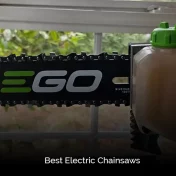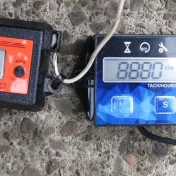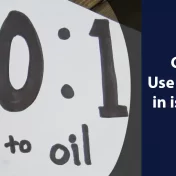Every vehicle, from the sleekest sports car to the most rugged truck, relies on a myriad of components working seamlessly together.
While some parts like the engine or transmission often steal the limelight, there are unsung heroes quietly working behind the scenes to ensure everything runs smoothly. One such component is the serpentine belt.
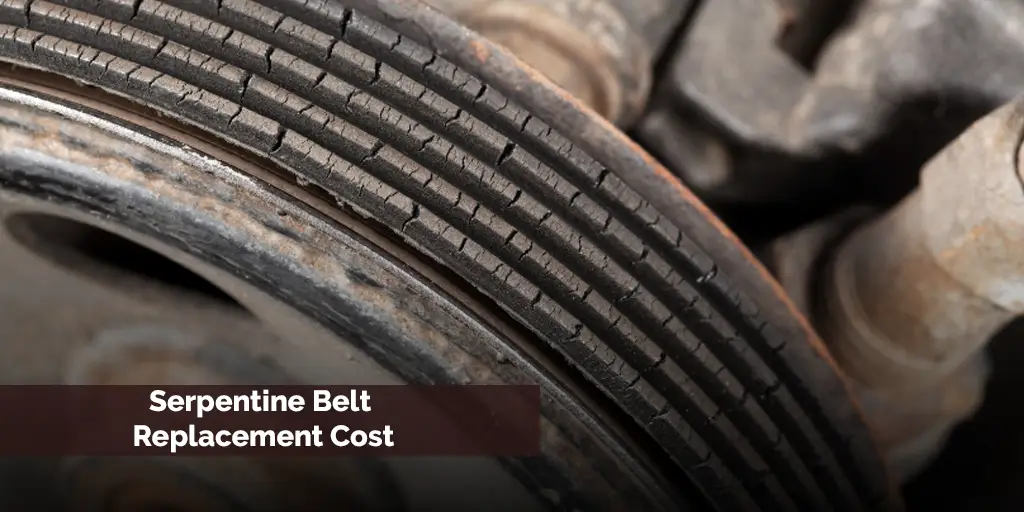
This seemingly simple piece of rubber plays a critical role in the operation of various vehicle systems, from charging the battery to cooling the engine.
But how much do we truly know about it? How can we recognize when it’s on its last leg, and most importantly, what does it cost to replace?
In this comprehensive guide, we’ll unravel the mysteries of the serpentine belt, diving deep into its history, importance, and the signs that it might be time for a replacement.
Whether you’re a car enthusiast looking to broaden your knowledge or someone trying to understand the serpentine belt replacement cost, this article has got you covered. Let’s drive in!
What Is A Serpentine Belt?
The serpentine belt, often referred to as the ‘drive belt’, is a pivotal component in most modern vehicles. This belt plays a crucial role in transmitting power from the engine’s crankshaft to several peripheral devices.
These devices, such as the alternator, power steering pump, water pump, and air conditioning compressor, rely heavily on the serpentine belt to function correctly.
If you hear a squealing noise from the front of your car, it might indicate a worn-out or broken serpentine belt.
Historically, cars used multiple belts to drive these devices. However, the evolution of auto repair and design has led to the more efficient use of a single serpentine belt.
Typically made of durable rubber compounds, it features a ribbed side that grips pulleys to prevent slippage, and a flat outer side.
Given its role in ensuring vital systems like power steering and air conditioning operate seamlessly, understanding this belt’s functionality and the signs of wearing is crucial.
A bad serpentine belt can jeopardize your vehicle’s performance and might even make it unsafe to continue to drive.
- Key Functions:
- Power Transmission: Efficiently transmits mechanical power from the engine, ensuring components like the water pump and power steering work smoothly.
- Versatility: Combines the functions of multiple belts, enhancing the vehicle’s overall efficiency.
- Flexibility: Designed to wind effortlessly around various pulleys, including the belt tensioner, which maintains optimal tension.
Belt replacement cost can vary based on the model of your vehicle and where you get it replaced. It’s always advisable to consult a reputable repair shop or auto repair specialist when considering serpentine belt replacement.
Typically, a serpentine belt lasts up to 100,000 miles, but it’s essential to be vigilant for any signs indicating it might need a replacement sooner.
In the upcoming sections, we’ll explore the indicators suggesting your belt might be nearing its end and the potential cost to replace a serpentine belt.
Signs Of A Bad Serpentine Belt
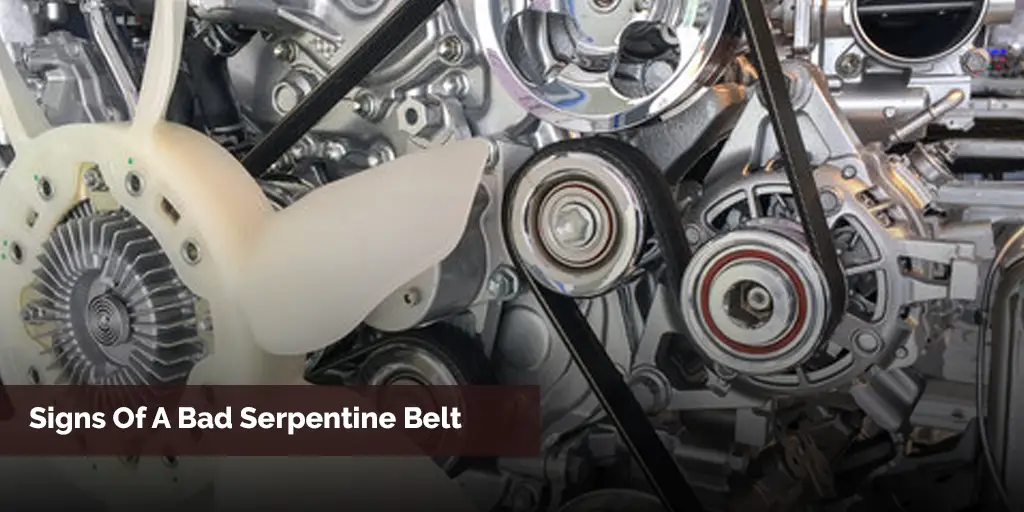
Detecting a bad serpentine belt early can save you both time and money. Here are some common signs that might indicate your belt is wearing out or has already broken:
- A Squealing Noise From The Front Of The Vehicle: One of the most common symptoms of a worn-out belt is a high-pitched squealing noise. This sound is often a result of the belt slipping on the pulleys, especially during startup or acceleration.
- Power Steering and AC Malfunctioning: If your serpentine belt is malfunctioning, it can impact the power steering pump and the air conditioning compressor. You might find it harder to steer your car or notice that the air conditioning isn’t cooling as efficiently as it should.
- Engine Overheating: The serpentine belt also powers the water pump, which circulates coolant throughout the engine. A broken or malfunctioning belt can lead to inadequate coolant circulation, causing the engine to overheat.
- Visible Cracks or Damage on the Belt: Inspect the belt regularly for signs of wearing, like cracks, fraying, or missing chunks. If you notice these signs, it’s an indication that your belt needs replacing soon.
- Wobbling Belt Tensioner: The belt tensioner ensures that the serpentine belt maintains the right tension. If it wobbles or moves excessively, it can indicate a belt issue or a failing tensioner.
- Unexpected Breakdowns: If your serpentine belt breaks while driving, it can lead to immediate power loss in vital systems. This can result in sudden breakdowns, making it unsafe to continue to drive. It’s always recommended to seek assistance from an auto repair specialist in such cases.
Note: If you’re unsure about the condition of your serpentine belt, it’s always a good idea to have it inspected by a professional at a repair shop. Regular checks can help you avoid unexpected belt replacement costs and potential damages to your vehicle.
When To Replace A Serpentine Belt

While serpentine belts are designed for durability, they don’t last forever. Knowing when to replace your belt can save you from unexpected breakdowns and potential damage to other vehicle components.
Here’s a guide to help you determine the optimal time for a serpentine belt replacement:
- Mileage Recommendation: Most manufacturers recommend replacing the serpentine belt every 60,000 to 100,000 miles. However, it’s essential to check your vehicle’s manual for specific recommendations based on the model of your vehicle.
- Visible Signs of Wear: As mentioned earlier, signs like cracks, fraying, or glazing on the belt surface indicate that it’s time for a replacement.
- Age of the Belt: Even if the belt shows no visible signs of wear, its rubber compounds degrade over time. If your belt is more than five years old, consider getting it inspected by an auto repair specialist.
- Unusual Noises: A persistent squealing noise from the engine compartment, especially during startup or on rainy days, is a clear indicator that your belt might be slipping and needs attention.
- Performance Issues: If you notice a decline in power steering efficiency, malfunctioning air conditioning, or the engine temperature rising above normal, it might be time to check the serpentine belt.
- After a Breakdown: If you’ve had a broken serpentine belt and managed to continue to drive to safety, replace the belt immediately. Driving without a functioning belt can cause severe damage to the engine and other components.
Pro Tip: While the belt replacement cost might seem like an additional expense, timely replacements can save you money in the long run by preventing potential damages to components like the water pump, alternator, or power steering pump.
How Much Does It Cost To Replace A Serpentine Belt?
The serpentine belt replacement cost can vary widely based on several factors. Here’s a breakdown to give you a clearer understanding:
- Type of Vehicle: The make, model, and year of your vehicle can significantly influence the cost. Luxury or specialized vehicles often have higher replacement costs due to the complexity or the quality of the parts used.
- Location: Labor costs can vary based on your geographical location. For instance, getting your belt replaced in urban areas or at dealerships might be more expensive than in a local repair shop in a smaller town.
- Labor: The bulk of the belt replacement cost often comes from labor. On average, the labor can range from $40 to $150, depending on the complexity of the replacement.
- Parts: The cost of the serpentine belt itself usually ranges from $25 to $75. However, if other components, like the belt tensioner, need replacement, the cost can go up.
- Additional Services: Some shops might recommend additional services, like a belt system inspection, which can add to the overall cost.
Average Cost Breakdown:
| Component | Average Cost ($) |
|---|---|
| Serpentine Belt | 25 – 75 |
| Labor | 40 – 150 |
| Belt Tensioner (if needed) | 20 – 60 |
| Additional Services | 10 – 50 |
Total Average Cost: $75 to $335
Note: These are average estimates, and actual costs can vary. It’s always advisable to get quotes from multiple service providers to ensure you’re getting a fair deal.
- Warranty: Some auto repair shops offer warranties on their work. While this might come at a slightly higher initial cost, it provides peace of mind knowing that any issues arising shortly after the replacement will be covered.
- DIY vs. Professional Replacement: While some car enthusiasts might consider replacing the serpentine belt themselves to save on labor costs, it’s essential to have the right tools and knowledge. If not done correctly, a DIY approach can lead to more significant issues and costs in the future.
In conclusion, while the upfront serpentine belt replacement cost might seem high, timely replacements are crucial for maintaining your vehicle’s optimal performance and preventing more expensive repairs down the line.
History of the Serpentine Belt
The story of the serpentine belt is one of innovation and the continuous pursuit of efficiency in the automotive world. Let’s journey through time and understand its evolution:
- The Era of Multiple Belts: Before the serpentine belt became mainstream, vehicles relied on multiple V-belts. Each of these belts would drive a single accessory. While this system worked, it was not without its challenges. Multiple belts meant increased weight, more maintenance, and a higher likelihood of one of them failing.
- Introduction of the Serpentine Belt: The serpentine belt, named for its snake-like appearance and winding path, was introduced as a solution to the limitations of V-belts. This single, long belt could drive multiple accessories, leading to a more compact engine design and reduced weight.
- Advancements in Material: Over the years, the materials used in serpentine belt replacement have seen significant advancements. From the initial rubber compounds, modern belts now incorporate materials like neoprene and EPDM, enhancing their durability and lifespan.
- Efficiency and Fuel Economy: With the adoption of the serpentine belt, engines could run more efficiently. Reduced friction, fewer belts, and an optimized path meant engines could deliver better fuel economy.
- Adoption by Auto Manufacturers: Recognizing the advantages of the serpentine belt, many auto manufacturers began incorporating them into their designs. Today, it’s rare to find new vehicles using multiple V-belts.
- Modern Challenges and Solutions: As vehicles have become more complex, so have their serpentine belt systems. Modern belts need to accommodate more accessories and tighter engine compartments. This has led to innovations in belt design, tensioning systems, and materials to ensure optimal performance.
Fun Fact: The name “serpentine” doesn’t just refer to the belt’s winding path. It also hints at its ability to adapt and change, much like a snake, to the evolving needs of modern vehicles.
Benefits of a Well-Functioning Serpentine Belt
A serpentine belt in good condition is more than just a piece of rubber; it’s a silent workhorse that ensures your vehicle runs smoothly. Here are some of the key benefits:
- Optimal Power Distribution: A well-functioning belt ensures that power from the engine’s crankshaft is efficiently distributed to various accessories, such as the alternator, power steering pump, air conditioning compressor, and water pump.
- Improved Fuel Efficiency: By reducing friction and ensuring that all components run optimally, a good serpentine belt can enhance your vehicle’s fuel efficiency, leading to cost savings at the pump.
- Longer Lifespan of Vehicle Components: A smooth-running belt reduces wear and tear on connected components. For instance, if the belt maintains proper tension and alignment, the belt tensioner and pulleys experience less strain, leading to longer component lifespans.
- Reduced Maintenance Costs: Timely serpentine belt replacement can prevent sudden breakdowns and the cascading failure of other components, saving you from unexpected and potentially costly repairs.
- Quiet Operation: A belt in good condition ensures silent operation. Gone are the squealing noises or vibrations that can be signs of a worn or broken serpentine belt.
- Safety: Perhaps the most crucial benefit is safety. A malfunctioning belt can lead to a sudden loss of power steering or an overheating engine, both of which can pose significant risks while driving. Ensuring your belt is in top condition can prevent such hazardous situations.
- Enhanced Resale Value: Regular maintenance, including taking care of the serpentine belt, can enhance the resale value of your vehicle. Prospective buyers often look for well-maintained vehicles, and a healthy serpentine belt system is a strong selling point.
Pro Tip: Always listen to your vehicle. If you notice any unusual noises or performance drops, it might be time for a check-up.
Regular inspections can help you reap all the benefits of a well-functioning serpentine belt and avoid the pitfalls of a malfunctioning one.
Risks of Ignoring a Bad Serpentine Belt
Ignoring the signs of a deteriorating serpentine belt can lead to various complications, both for your vehicle and your wallet. Here are the potential risks:
- Engine Overheating: The serpentine belt drives the water pump, ensuring the circulation of coolant throughout the engine. A malfunctioning belt can hinder this process, leading to insufficient cooling and eventual engine overheating.
- Loss of Power Steering: One of the essential functions of the serpentine belt is to power the steering pump. A broken serpentine belt can result in the sudden loss of power steering, making it challenging and potentially dangerous to maneuver the vehicle.
- Air Conditioning Failure: If you’re wondering why your vehicle’s air conditioning isn’t cooling efficiently, a worn-out belt might be the culprit. The belt powers the AC compressor, and any malfunction can affect the system’s performance.
- Battery Drain: The alternator, responsible for charging the vehicle’s battery, is also powered by the serpentine belt. A non-functioning belt can lead to the battery not charging, resulting in a drained battery and potential start-up issues.
- Increased Repair Costs: Ignoring early signs of wear can lead to the belt snapping or other components failing. This can escalate the belt replacement cost and might also involve repairing or replacing other damaged components.
- Safety Concerns: A sudden belt failure while driving can lead to a loss of essential functions, posing significant safety risks. For instance, losing power steering in the middle of a turn can be dangerous.
- Decreased Vehicle Lifespan: Consistently ignoring maintenance, including timely serpentine belt replacement, can reduce the overall lifespan of your vehicle.
- Reduced Fuel Efficiency: A malfunctioning belt can increase engine load and friction, leading to decreased fuel efficiency.
Note: It’s always advisable to address any potential issues with the serpentine belt promptly. Regular inspections and timely replacements can save you from the above risks and ensure a smoother driving experience.
DIY vs. Professional Replacement
When it comes to serpentine belt replacement, vehicle owners often ponder whether to take the DIY route or consult a professional at a repair shop. Both approaches have their merits and challenges:
DIY (Do It Yourself)
Pros:
- Cost Savings: By handling the replacement yourself, you can save on labor costs associated with professional services.
- Learning Experience: It provides an opportunity to understand your vehicle better and gain hands-on experience.
- Convenience: You can choose a suitable time for the replacement without having to schedule an appointment.
Cons:
- Potential Mistakes: Without proper experience or tools, there’s a risk of making mistakes, which can lead to more significant issues or additional costs in the future.
- Time-Consuming: Especially for beginners, the process can be time-consuming as you figure out the steps.
- Lack of Warranty: DIY replacements typically don’t come with a service warranty. If something goes wrong, you’re on your own.
Professional Replacement
Pros:
- Expertise: Professionals at an auto repair shop have the experience and knowledge to ensure the replacement is done correctly.
- Efficiency: With their expertise, professionals can complete the task much faster than an amateur.
- Warranty: Many repair shops offer warranties on their work, providing peace of mind.
- Comprehensive Inspection: A professional might identify other potential issues during the replacement, ensuring your vehicle remains in top condition.
Cons:
- Cost: Professional services come with labor costs, making the replacement more expensive than a DIY approach.
- Scheduling: Depending on the shop’s availability, you might need to schedule an appointment and potentially be without your vehicle for a duration.
Note: If you’re considering the DIY route, it’s crucial to have the right tools and a comprehensive guide or manual. Always prioritize safety, and if you’re unsure at any step, it’s better to consult a professional.
You May Also Enjoy Reading:
Maintenance Tips
Ensuring the longevity of your serpentine belt not only saves you money on replacements but also guarantees the optimal performance of your vehicle. Here are some maintenance tips to consider:
- Regular Inspections: At least twice a year, visually inspect your serpentine belt for signs of wear, such as cracks, fraying, or glazing. Regular checks can help you spot issues before they escalate.
- Listen to Your Vehicle: A squealing noise or vibrations from the front of your car can indicate a slipping or worn-out belt. Address such signs promptly to prevent further complications.
- Ensure Proper Tension: The serpentine belt operates efficiently when it’s under the right tension. A loose belt can slip, while an overly tight one can wear out quickly. Ensure that the belt tensioner is functioning correctly.
- Avoid Oil and Fluid Leaks: Exposure to engine oil or other fluids can degrade the belt’s material, reducing its lifespan. If you notice any leaks, address them immediately and clean any residue from the belt.
- Replace Ancillary Components: When replacing the serpentine belt, consider checking and replacing related components like the belt tensioner and pulleys, if necessary. These components work in tandem, and a worn-out pulley can reduce the new belt’s lifespan.
- Use Quality Replacement Parts: When it’s time for a serpentine belt replacement, opt for high-quality belts from reputable brands. While they might be slightly more expensive upfront, they often last longer and provide better performance.
- Stay Updated: Regularly check your vehicle manufacturer’s guidelines and recommendations. As vehicles evolve, maintenance tips and schedules might change, so it’s essential to stay updated.
- Seek Professional Advice: If you’re unsure about the belt’s condition or the right maintenance steps, consult a professional at an auto repair shop. Their expertise can provide valuable insights and recommendations.
Pro Tip: While the serpentine belt is designed to last many miles, external factors like extreme temperatures, dust, or contaminants can reduce its lifespan.
Being aware of your driving conditions and adjusting your maintenance routine accordingly can help ensure the belt’s longevity.
Frequently Asked Questions (FAQs)
1. What’s the difference between a serpentine belt and a drive belt?
While some use these terms interchangeably, the primary distinction is that a drive belt can refer to any belt that drives accessories off the engine’s crankshaft.
A serpentine belt is a type of drive belt that winds around multiple pulleys in a ‘serpentine’ fashion.
2. Can I drive my car if the serpentine belt breaks?
While it’s technically possible to continue to drive after a belt breaks, it’s highly discouraged. A broken belt means that essential systems like power steering, the alternator, and the water pump won’t function, making it risky and potentially damaging to your vehicle.
3. How long does it take to replace a serpentine belt?
The duration depends on the vehicle model and the technician’s experience. On average, a professional can replace a serpentine belt in 30 minutes to 2 hours.
4. Can a bad serpentine belt cause battery issues?
Yes, the serpentine belt powers the alternator, which charges the vehicle’s battery. A malfunctioning belt can lead to a battery not charging properly or even draining over time.
5. Should I replace the belt tensioner with the serpentine belt?
While not always necessary, it’s a good practice. The tensioner ensures the belt maintains optimal tension, and if it’s worn out, it can lead to premature belt wear.
6. How can I determine the *belt replacement cost* for my specific vehicle model?
The best approach is to consult your vehicle’s manual for guidelines and then get quotes from multiple auto repair shops or dealerships for a comprehensive estimate.
7. Is the serpentine belt the same as a timing belt?
No, they serve different functions. The serpentine belt drives external engine accessories like the alternator and power steering pump.
In contrast, the timing belt (or chain) ensures the internal engine components, like the camshaft and crankshaft, synchronize.
Conclusion
The serpentine belt is undeniably one of the unsung heroes of modern vehicles. Its role in ensuring various components receive power efficiently and consistently is pivotal for a car’s optimal performance.
From understanding its history and benefits to recognizing the signs of wear and knowing when to replace it, we’ve taken a comprehensive look at this essential component.
Regular maintenance and timely replacements can prevent sudden breakdowns, ensuring your vehicle remains reliable and safe.
While the serpentine belt replacement cost might seem like an added expense, it’s a small price to pay for the peace of mind and the longevity of your vehicle’s components.
As always, whether you’re considering a DIY approach or seeking professional services, ensure safety is a priority.
Regular inspections, quality replacements, and staying informed can go a long way in guaranteeing your vehicle’s smooth operation for miles to come.
Thank you for joining us on this journey through the world of serpentine belts. Drive safe!
